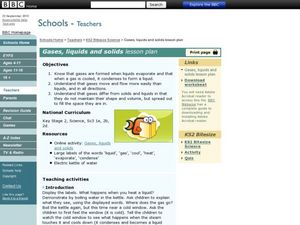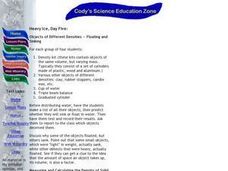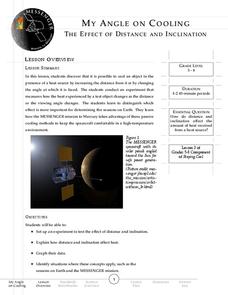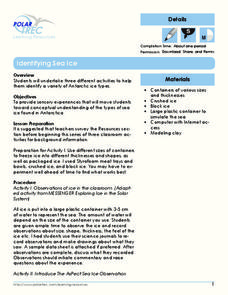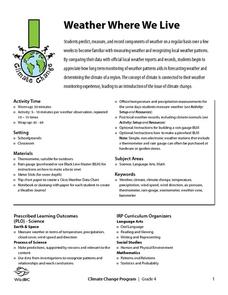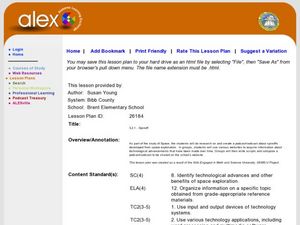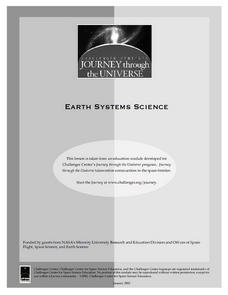Curated OER
Gases, Liquids and Solids, evaporate, shape volume,
Students conduct an online experiment to discover what happens to solids, liquids and gases in different temperatures. For this states of matter lesson, students get into pairs and work in a virtual laboratory to...
Curated OER
A Journey Through Our Solar System
Students investigate the concept of the solar system in our universe by constructing a model that is made to a measurable scale. Once the model is constructed it should be placed in a wide open space for observation and demonstration...
Curated OER
Heavy Ice: Day Five
Students explore physics by conducting a class experiment. In this density lesson, students examine a list of items and discuss whether they will sink or float and then determine their density. Students examine the objects over five days...
Curated OER
Energetic Atoms - Active & Spaced Out
Students discover the power of the sun through an outdoor experiment. In this solar power lesson, students view a PowerPoint presentation on atoms before they complete an atom worksheet. Students utilize a solar bag to...
Space Awareness
What is Time?
Does it ever seem like time is slipping through your fingers? Model the passing of time with an hourglass activity in which individuals determine whether hourglasses are the most efficient way to measure time.
Messenger Education
My Angle on Cooling—Effect of Distance and Inclination
When exploring Mars, spacecrafts are exposed to 5-11 times more sunlight than when near Earth. Groups of pupils complete a hands-on activity to explore how distance and angle of the sun affect temperature. Through discussions, they then...
BioEd Online
The Skeleton
Don't be chicken to try a lesson plan that compares the anatomy of birds to humans. Read the background information so you don't have to wing it when it comes to the anatomy of a chicken. Prepare cooked chicken bones by soaking them in a...
Baylor College
Energy Sources
Take the concept of burning calories to a more literal level in the second of seven lessons about energy in the realm of food and fitness. Using simple materials, groups will burn breakfast cereal and a pecan to see which one gives off...
Polar Trec
Identifying Sea Ice
Sea ice contains 17 sub-types based on age and various characteristics. Scholars observe ice floating in a simulated ocean and record their observations. Then, they view photographs of different types of sea ice and learn to...
Wild BC
Weather Where We Live
Over a span of two weeks or more, mini meteorologists record weather-related measurements. What makes this particular resource different from others covering similar activities are the thorough details for the teacher and printables for...
LABScI
Viscosity: The Fluid Lab
There's more to fluids than meet the eye—they include gases, liquids, and polymers, too! Scholars complete three hands-on activities exploring different properties of fluids. They explore viscosity by measuring the resistance, or...
Curated OER
Experiment: Faster Air = Lower Air Pressure 2
Students experiment to observe air current and pressure.
Curated OER
Black Holes
Students explore what black holes are and how gravity is associated with them. In this space lesson students are given enough information to imagine a journey to a black hole.
Curated OER
Properties of Dust
Students examine the dust in their classroom and relate it to the dust in space. In this investigative instructional activity students collect dust and graph their findings.
Curated OER
What’s That, I Can’t Hear You?
Students investigate forms of energy as well as light and sound. In this science instructional activity, students participate in hands-on activities that require them to evaluate how sound affects astronauts in flight. A video of this...
Curated OER
3,2,1.....Spinoff
Students investigate spinoffs of space exploration. In this space exploration lesson, students conduct research regarding technological advancements. Students use the information gained to write a script and produce a podcast.
Curated OER
The Solar System
Students examine the solar space program and research what options are the most viable. In this solar system instructional activity students view a video on the solar system, research the Internet and make recommendations.
Curated OER
Build a Block Model
Learners construct a block model of the Space Station. They develop a description of their procedures, complete flow diagrams of their processes, develop a budget, and present their block model to the class.
Curated OER
Land Safely...
Students model the preparation needed for a soft-landing on a planet or object in space. They do this by packaging a raw egg with certain material, and dropping the egg from a given height to test the packaging effectiveness.
Curated OER
SKY PATHS: STUDYING THE MOVEMENT OF CELESTIAL OBJECTS
Students observe the position of an object in the sky by describing its location relative to another object or the background, describe an object's motion by tracing and measuring its position over time, and create their own myths about...
Curated OER
Earth, Sun and Moon
Students investigate that the sun is at the center of the solar system through role play. One student is the sun and one student is the Earth. The students then show how the Earth orbits around the sun. Students view a flashlight and...
Curated OER
Solar System: The Four Inner Planets and Earth's Moon and Astronauts
Second graders read THe Magic School Bus: Lost in the Solar System. For this language arts and science lesson, 2nd graders explore the four inner planets. Students view the inner planets using Google Earth.
Curated OER
Historic Earth Science Innovations
Students research the demands or limitations on Earth scientists. In groups, they design and build a model that would be useful to them in the lab or field. They share their model and their ideas behind it to the class and answer any...
Curated OER
soil, Water, and Plants
Students examine the relationship between water retention and plant growth by conducting two experiments. They first compare the water retention qualities of clay, sand and loam soil types. Then they use the data from the first...
